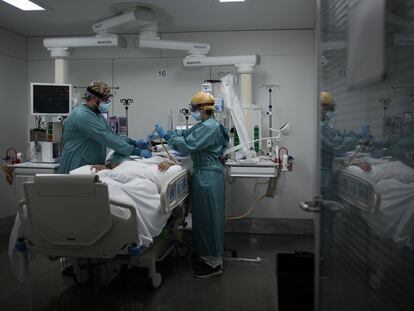Spain sets seven-day record for Covid deaths in second wave
The number of victims over the last week came in at 1,002 in the latest Health Ministry report, double the figure from one month ago. The infection rate, meanwhile, is starting to slow

The coronavirus data released by Spain’s Health Ministry on Thursday has a double reading. The negative side is that the country’s regions reported 1,002 Covid-19-related deaths in the last seven days, the highest figure in this second wave so far. Of these fatalities, 368 were reported in the previous 24 hours. This is the first time in this phase of the pandemic that the former data point has exceeded 1,000. A month ago, on October 5, the number was 366. The total death toll now stands at 38,846. Given that rising Covid deaths reflect a rise in cases from several weeks ago, the number of fatalities is likely to continue increasing given where new infections were headed at that time.
On the other hand, the 14-day cumulative number of coronavirus cases per 100,000 inhabitants – the parameter that shows the progress of new infections – fell in Thursday’s report. The decrease was small, dropping from 528.75 to 527.30 in 24 hours, but it does confirm that the rise in positives is slowing, suggesting that the ever-stricter measures being put in place in recent weeks by Spain’s regions are having an effect. That said, the number of new infections included in the ministry’s latest report was 21,908, the fifth-highest figure in the second wave. There have been a total of 1,306,316 confirmed infections in Spain since the pandemic began.
Even if the stabilization of transmission is consolidated, that doesn’t mean that pressure on the healthcare system is reducingFernando Simón, director of the Health Ministry’s Coordination Center for Health Alerts (CCAES)
The fall in the cumulative incidence is down after nine of Spain’s 19 territories (the 17 regions and the autonomous cities of Ceuta and Melilla) reported drops in the last 24 hours. They are Andalusia, Aragón, Cantabria, Castilla y León, Catalonia, Valencia, Madrid, Melilla and Navarre. The curve of new cases had already seen a slowdown before yesterday’s report: the two-week incidence rate went up 7.4% on November 2, 1.3% on November 3, and 0.15% on November 4. In the last 24 hours the rate fell 0.15%.
Fernando Simón, the director of the Health Ministry’s Coordination Center for Health Alerts (CCAES), said on Thursday that “a lot of care must be taken with the interpretation” of the figures, and avoided using the word “decrease” and referred instead to a “certain stabilization,” insisting that a week at least would be needed before the trend could be evaluated. Simón wants to avoid what happened some three weeks ago, when the curve appeared to be flattening only to later strongly rebound.
As for the possible causes of this fall, Simón repeated that the regions are taking “very drastic” measures but without singling out any territory that is managing the situation better than another. Madrid, the Canary Islands and Navarre are those that have best brought down the curve this week compared with last. On the other end of the scale, meanwhile, is the Basque Country, whose cumulative incidence over seven days per 100,000 inhabitants is now double the Spanish average. The northern region decided on Thursday to close all bars and restaurants and brought forward its curfew start time to 10pm, Mikel Ormazabal reports.
Simón explained on Thursday that “even if the stabilization of transmission is consolidated, that doesn’t mean that pressure on the healthcare system is reducing,” given that occupation of hospital beds and intensive care units (ICUs) reflects the progress of the pandemic with “10 or 15 days’ delay.”
The Basque Country decided on Thursday to close all bars and restaurants and brought forward its curfew start time to 10pm
The ministry official pointed to the fact that the proportion of hospital beds taken up by Covid patients is “very high,” and that until now, while the majority of regions have been able to maintain their programmed activity, some are now facing problems.
According to Thursday’s report, 16.35% of Spain’s hospital beds are occupied by Covid patients, a figure that is unchanged from the day before. A total of 20,281 people are currently admitted for treatment, compared to 10,949 a month ago. ICU occupation is also very high, at 19.20%, a figure also unchanged from the day before. There are currently 2,802 patients in ICU beds across Spain.
As a consequence of the slowdown in new cases, the positivity rate – the proportion of coronavirus tests that come back positive – is holding steady at 13%, having come in at 13.7% a week ago. In this period, the number of tests carried out has risen from 1,063,770 to 1,205,303. Simón pointed to the fact that it was a good sign that there were fewer positives coming back from a higher number of tests.
The government’s chief epidemiologist also explained on Thursday that there are currently 1,567 active outbreaks, which are the origin of 10,559 cases. Among these he focused on those that have affected adolescents and youngsters, although he highlighted that transmission is not taking place in the classroom, but rather in social settings. Something similar is being seen among healthcare workers. While a total of 5,479 infections have been detected among medical staff in the last two weeks, transmission has not taken place at work, and the incidence is similar to that among the general population. Simón pointed to the fact that the lessons learned since the start of the pandemic and the precautionary measures in place are working.
English version by Simon Hunter.
Tu suscripción se está usando en otro dispositivo
¿Quieres añadir otro usuario a tu suscripción?
Si continúas leyendo en este dispositivo, no se podrá leer en el otro.
FlechaTu suscripción se está usando en otro dispositivo y solo puedes acceder a EL PAÍS desde un dispositivo a la vez.
Si quieres compartir tu cuenta, cambia tu suscripción a la modalidad Premium, así podrás añadir otro usuario. Cada uno accederá con su propia cuenta de email, lo que os permitirá personalizar vuestra experiencia en EL PAÍS.
¿Tienes una suscripción de empresa? Accede aquí para contratar más cuentas.
En el caso de no saber quién está usando tu cuenta, te recomendamos cambiar tu contraseña aquí.
Si decides continuar compartiendo tu cuenta, este mensaje se mostrará en tu dispositivo y en el de la otra persona que está usando tu cuenta de forma indefinida, afectando a tu experiencia de lectura. Puedes consultar aquí los términos y condiciones de la suscripción digital.










































